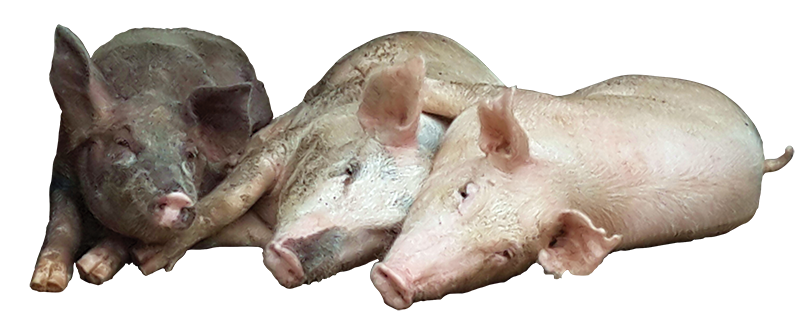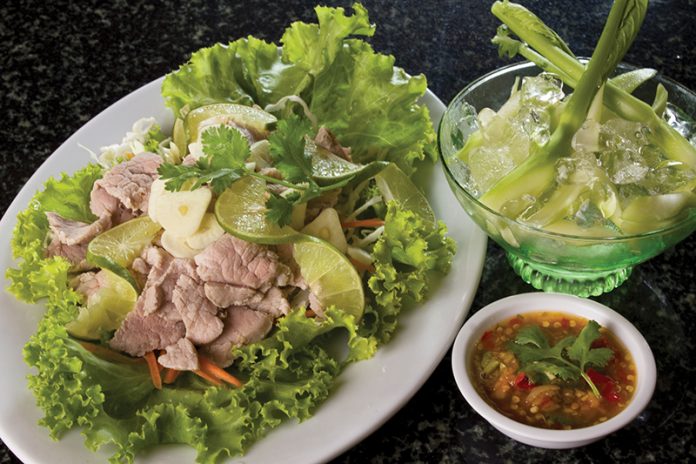At Trattoria Pizzeria Toscana Italian Restaurant and its neighbouring sister Thai restaurant Moom Talay, (both located just in front of Soi 6 and 7 on Pattaya beach road), you can find some fantastic delicacies on the menu including succulent pork and wild boar.
Pork

It is important to dispel the prejudices that persist about the nutritional value of pork. Fresh pork meat is a great alternative to beef, both from the nutritional point of view and economically, however Italians continue to prefer the latter.
These prejudices, no longer have any reason to be in force. In fact, the pig industry has diversified its activities into two strands: pig production with more mature pigs weighing 150-200 kg for the preparation of hams, sausages and various meat products and then the harvesting of younger pigs around 6 months old and weighing about 90kg to provide a very tender fresh meat, palatable and with a fat content comparable to that of beef.
These results, combined with the fact that pork has a lower price than that of beef, have lead to production being quadrupled in the last twenty years.
Fresh pork has a pale pink color. The color varies depending on the breed, feed, age and, in the same animal, the different muscle groups.
The boar and the sow for example, have darker meat, while the piglet (typically 6-7 weeks fed exclusively on milk), presents much clearer meat. The appearance of pigmeat is velvety, with veined white or slightly pinkish fat.
The chemical composition of pigmeat is similar to that of other types of meat, both as regards the content of protein and fat and for calorie intake. The proteins have an amino acid composition very similar to that of beef and also have a high coefficient of digestibility. The lipid fraction instead differs from that of beef. In fact pork contains a higher percentage of polyunsaturated fatty acids such as linoleic and linolenic acids, a very positive thing as it is thought that these have a recognized anticolesterolemica action.
Pork is a great source of B vitamins, especially thiamine, which is estimated in other meats at around 0.15 mg per hundred grams, but reaches four times these values in pork.
The cuts that are frequently intended for consumption in the fresh state are: tenderloin, sirloin, loin, ribs, legs, head, and bacon. Prime cuts are those characterized by lean and very tender meat, and include Thread, Lonza, Carré, and Leg and shoulder.
Thread, is a thin, elongated anatomical portion that goes from the end of the shoulder to the first rib. It’s thin, tender and very tasty. It presents a rather dark color.
Lonza is located above the fillet at the sides of the spine. It has elongated shape, lighter color and lends itself to various preparations and can be cooked stewed, roasted or fried.
Carré is located in front of the animal and is the continuation of the sirloin. When it is boned and cooked whole, the roast is called Arista.
Leg belongs to the hindquarter. Although often used for hams, it has delicate meat. It lends itself beautifully to the roasting spit.
Shoulder belongs to the prior quarter. Although it is traditionally used to prepare ham (cooked shoulder), it is also excellent roasted or stewed.
Intermediate and lower cuts consist of more or less infiltrated fat from meat and include Ribs, Feet, Head, Pillow and Bacon.
Ribs are formed from the pork ribs with connective tissue and muscle portions. Not very rich in meat, however, they are very tasty and are used in special dishes like cassoeula.
Feet are the legs of the pig. They are cooked with all the rind and therefore require longer cooking times.
Head, also called the Musetto, is of course the pig’s head. Although frequently used for so-called “head cheese” or brawn (salami), It can be cooked or boiled and stewed. Like legs, it requires a long cooking time.
Pillow is a fatty part of the pig made from the pig’s head. It is used in the preparation of typical dishes such as amatriciana sauce (Roman) or muset and brovade (Friuli). In addition to the fresh state, it is also sold preserved in salt. However,
Bacon is derived from the fatty part of the pig’s belly. It has a more limited thickness of fat and is richer in meat. Often, to help in the preservation, it is lightly salted.
When buying pork, check with the butcher if the meat was butchered fresh. If so, it is good to store it in the refrigerator for a few days (preferably wrapped in wax paper) to allow for maturation to occur, which will give the best tenderness and flavor.
You should also know how to choose the cooking method appropriate for each type of cut, to improve the palatability.
Grilling is very suitable for chops and steaks, derived respectively from the yoke, from the tenderloin and the loin. It is good to carefully avoid the formation of burns, or charred parts since the substances that are formed at the high temperature can be harmful.
Roasting can be conducted at high heat or in the oven; in this case the meat is softer and provides for a more homogeneous cooking. The temperature reaches 180 degrees outside, but the time should be extended.
The wild boar

The wild boar (Sus scrofa) is a wild suida spread throughout the Mediterranean. Wild boar meat is very tasty and now readily available in large supermarkets especially frozen. Wild boar meat is renowned and appreciated as it combines the flavor of the pork with game.
Wild Boar is a wild pig and is aggressive. The size varies depending on the subspecies. Its origins date back to a time before the appearance of man. It is currently present in Central Europe and South Asia and Indonesia. In North America it was brought by the Spaniards in the mid-sixteenth century. In Africa and South America there are animals like wild boar, such as warthog and peccary.
Wild boar meat is rather fibrous and so is particularly suitable for cooking in the pan, such as stews or sauces. It may, however, also be roasted or broiled.
Small wild boar is considered particularly tasty by connoisseurs and is typically roasted whole. The quality of the meat cuts are the same as those of the pig. Favorite cuts include wild boar thighs, but in some areas also the head meat is considered a delicacy.
Typical dishes are pappardelle with wild boar sauce or wild boar Maremma, rather hearty and typical of the Tuscan region. Stew is prepared and served with polenta or pasta. You can also find wild boar sauce prepared commercially.
Wild boar ham is preferred because it easier to find without preservatives or with nitrate and antioxidant. At Moom Talay and Trattoria Pizzeria Toscana the staff cultivate it in the old fashioned, traditional way to avoid any instances of chemicals. Whilst preserved wild boar meat is common, Moom Talay and Trattoria Pizzeria Toscana mainly sell their products as fresh as possible
In Europe and Asia since ancient times hunting wild boar was considered a warrior activity due to the dangerous nature of the prey.
Their behavior, color and strength gave them the nickname “black beast”, often associated with the personification of evil.
In the Middle Ages and the Renaissance people continued to appreciate the gastronomic characteristics of this animal, but in later times, the spread of agriculture meant that the wild boar’s habitat became limited and the animal was considered a pest for crops.
By the end of the year 800 wild boar was confined to certain areas of Tuscany, Lazio and Calabria, areas from which we have received many traditional recipes.
Luca, the owner of Moom Talay and Trattoria Pizzeria Toscana takes a lot of pride in his offerings. Both wild boar and pigs are raised at Luca’s specialist farm and this enables the restaurants to provide a very wide range of the freshest cold cuts and tender pre cooked meats.











